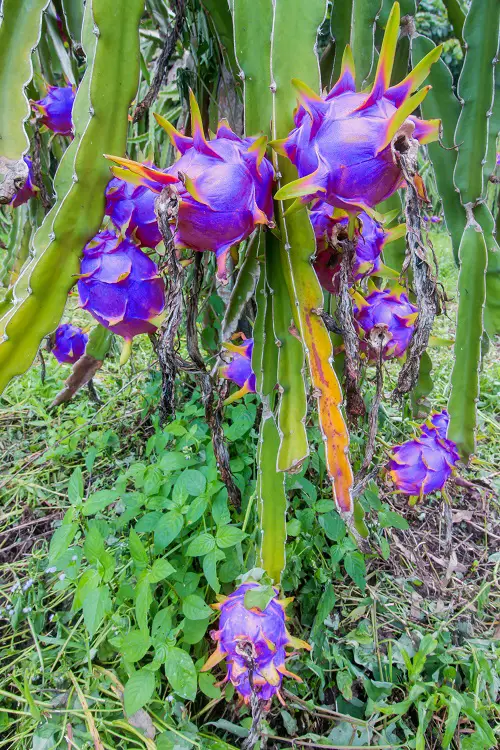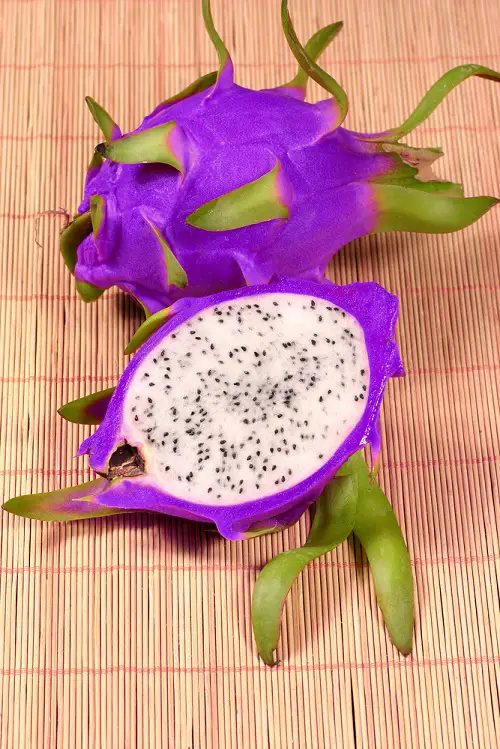Blue Dragon Fruit – Is it real? Can you grow it in your garden? Let us answer all your questions and clear the doubts!

The existence of Blue Dragon Fruit has sparked curiosity and debate among horticulturists, fruit enthusiasts, and the general public. However, the question remains: Is it real, or is it merely a myth? Let’s find out!
Blue Dragon Fruit – Scientific Evidence

The commonly known dragon fruit plants produce fruits with skin that ranges from pink to red and flesh that is either white or red. A yellow-skinned variety also exists, but there is no scientifically recognized blue variety.
Hybrid and Genetically Modified Plants
1. Breeding Programs
Plant breeding programs continually experiment with hybridization to produce new fruit colors and traits. However, no blue dragon fruit has been successfully developed and documented.
2. Genetic Modification
The potential for genetic modification exists, but as of my last update, no genetically modified blue dragon fruit has been introduced to the market.
Online Myths and Misconceptions
1. Altered Images
Photos of these plants circulating online are often digitally altered. While these images may capture the imagination, they should not be considered factual representations.
2. Marketing Schemes
Some vendors may advertise seeds for these plants, but these are likely misleading or fraudulent claims. Buyers should exercise caution and seek credible sources.
The Future of Blue Dragon Fruit: Possibilities and Promises

The prospect of creating a specifically colored fruit holds both scientific intrigue and market potential. Advancements in plant breeding and genetic engineering in the future could make it a reality.
1. Hybridization
Traditional plant breeding methods, including cross-breeding different fruit varieties, could potentially yield a blue one. However, this approach might require several generations of breeding and is generally considered less precise.
Different Types of Pink Fruits to Grow in Garden
2. Genetic Engineering
Advanced genetic modification techniques, such as CRISPR, offer the possibility of directly altering the genes responsible for fruit color.
By modifying these genes, scientists could potentially create a blue dragon fruit more quickly and accurately than through traditional breeding methods.
The Promise of a Blue Dragon Fruit
1. Market Appeal
A blue dragon fruit would likely attract significant consumer interest due to its unique color. This could potentially expand the market for these plants and elevate their status as a luxury or novelty item.
2. Nutritional Enhancements
Genetic modifications could go beyond just color. Scientists could potentially fortify the fruit with additional nutrients, thereby increasing its health benefits.
3. Intellectual Property
Creating a new fruit variety could offer lucrative patenting opportunities. Companies that develop this fruit in color could gain exclusive rights to its production and distribution, making it a potentially profitable endeavor.
Challenges and Ethical Considerations
1. Safety Concerns
Any genetically modified fruit would require rigorous testing to ensure it’s safe for consumption and doesn’t harm the environment.
Best Blue Fruits | Delicious Blue Fruits that are Blue
2. Ethical Debate
Genetic modification remains a contentious issue, with various ethical considerations related to tampering with natural ecosystems and the commercialization of genetically modified organisms.
3. Regulatory Hurdles
Developing a genetically modified plant would require navigating complex regulatory landscapes, which could involve lengthy approval processes.
Blue Dragon Fruit – Conclusion
While the notion of the plant is intriguing, there is no scientific evidence to support its existence. Commonly varieties come in shades of pink, red, and yellow, but not blue. Until credible documentation becomes available, this plant remains a myth!


